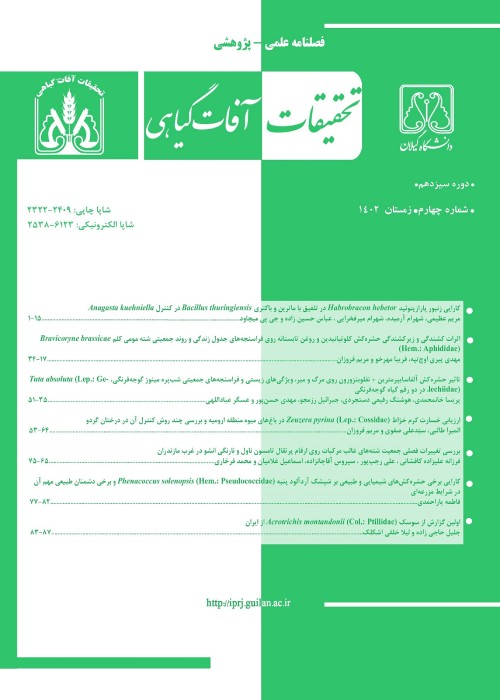Effect of Nanoformulation on toxicity of some herbal extracts against two-spotted spider mite Tetranychus urticae and Silverleaf whitefly Bemisia tabaci
Author(s):
Article Type:
Research/Original Article (دارای رتبه معتبر)
Abstract:
The present study was designed to evaluate the lethal effects of aqueous extracts and nanoformulations of Rosmarinus officinalis L., Lavandula angustifolia Mill., Eucalyptus globulus Labill. and Artemisia dracunculus L. on Tetranychus urticae Koch (female and male adults) and Cuminum cyminum L. and Coriandrum sativum L. on Bemisia tabaci (Gennadius) (first and third instar) under laboratory conditions at 25 ± 2 ºC, 60% RH, and 16:8 h. photoperiod using contact toxicity method. Among aqueous and formulated extracts rosemary (LC50 = 3227 ppm) and tarragon (LC50 = 1454 ppm) had the highest toxicity against adult mites, respectively. Aqueous and formulated extracts of cumin also showed the highest toxicity with LC50 of 9639 and 6748 ppm on the first instar and 11670 and 9937 ppm on the third instar of B. tabaci, respectively. The first instar of B. tabaci showed more sensitivity to aqueous and formulated extracts than third ones. Based on the results of high-performance liquid chromatography (HPLC), Salcillic acid for rosemary (21.68%), lavender (33.90%) and coriander (9.9%), and quercetin for eucalyptus (76.62%), tarragon (23.49%) and cumin (15.68%) had the highest amount of chemical compounds. Our findings show the reliable toxicity of plant extracts and will facilitate the use of plant products in integrated pest management programs under greenhouse conditions.
Keywords:
Language:
Persian
Published:
Journal of Plant Pests Research, Volume:13 Issue: 2, 2023
Pages:
67 to 80
magiran.com/p2616798
دانلود و مطالعه متن این مقاله با یکی از روشهای زیر امکان پذیر است:
اشتراک شخصی
با عضویت و پرداخت آنلاین حق اشتراک یکساله به مبلغ 1,390,000ريال میتوانید 70 عنوان مطلب دانلود کنید!
اشتراک سازمانی
به کتابخانه دانشگاه یا محل کار خود پیشنهاد کنید تا اشتراک سازمانی این پایگاه را برای دسترسی نامحدود همه کاربران به متن مطالب تهیه نمایند!
توجه!
- حق عضویت دریافتی صرف حمایت از نشریات عضو و نگهداری، تکمیل و توسعه مگیران میشود.
- پرداخت حق اشتراک و دانلود مقالات اجازه بازنشر آن در سایر رسانههای چاپی و دیجیتال را به کاربر نمیدهد.
In order to view content subscription is required
Personal subscription
Subscribe magiran.com for 70 € euros via PayPal and download 70 articles during a year.
Organization subscription
Please contact us to subscribe your university or library for unlimited access!


